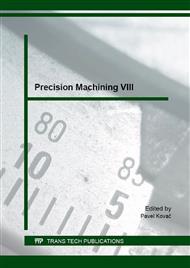[1]
P.G. Benardos and G.C. Vosniakos, Predicting surface roughness in machining, International Journal of Machine Tools and Manufacture, 43 (2003) 833-844.
DOI: 10.1016/s0890-6955(03)00059-2
Google Scholar
[2]
J. Beňo, I. Maňková, M. Vrabel, D. Kottfer, Roughness measurement methodology for selection of tool inserts, Measurement, 46 (2013), 582-592.
DOI: 10.1016/j.measurement.2012.08.017
Google Scholar
[3]
M. Vrabel, I. Maňková, J. Beňo, Surface Roughness Modeling and Prediction by ANN when Drilling Udimet 720, Key Engineering Materials 581 (2014) 366-371.
DOI: 10.4028/www.scientific.net/kem.581.366
Google Scholar
[4]
W. Zebala, R. Kowalczyk, Estimating the effect of cutting data on surface roughness and cutting force during WC-Co turning with PCD tool using Taguchi design and ANOVA analysis, International Journal of Advanced Manufacturing Technology, 77 (2015).
DOI: 10.1007/s00170-014-6382-6
Google Scholar
[5]
M.N. Durakbasa, P.H. Osanna, G. Bas, P. Demircioglu, M. Cakmakci, A. Hornikova, Novel Developments in Dimensional Nanometrology in the Context of Geometrical Product Specifications and Verification (GPS),
JAMRIS - Journal of Automation, Mobile Robotics & Intelligent Systems, 6 (2012).
Google Scholar
[6]
M.N. Durakbasa, P.H. Osanna, P. Demircioglu, The Factors Affecting Surface Roughness Measurements of the Machined Flat and Spherical Surface Structures - The Geometry and the Precision of the Surface, Measurement, 44 (2011) 1986 – (1999).
DOI: 10.1016/j.measurement.2011.08.020
Google Scholar
[7]
B. Palásti-Kovács, S. Sipos, I. Szalóki, Experimental research of cutting performance and quality abilities of modern drilling tools, Key Engineering Materials, 581 (2014) 32-37.
DOI: 10.4028/www.scientific.net/kem.581.32
Google Scholar
[8]
I. Szalóki, Analysis of drilling surface microgeometry, 2nd Regional Conference - Mechatronics in Practice and Education, Subotica, Serbia, December 5-6. 2013. pp.111-114 ISBN 978-86-7892-565-8.
Google Scholar
[9]
M. Balázs, J. Beno, Effect of the Working Diameter to the Surface Quality in Free-form Surface Milling, Key Engineering Materials, 581 (2014) 372-377.
DOI: 10.4028/www.scientific.net/kem.581.372
Google Scholar
[10]
I. Dudás, G. Varga, 3D topography for environmentally friendly machined surfaces, Journal of Physics: Conference Series, 13 (2005) 24-27.
DOI: 10.1088/1742-6596/13/1/006
Google Scholar
[11]
B. Karpuschewski, T. Emmer, K. Schmidt, D. T. Nguyen, Flexible tool concept based on circle shanks for high performance cutting, CIRP International Conference High Performance Cutting, 3 (Dublin), 1 (2013) 305-314.
Google Scholar
[12]
B. Karpuschewski, S. Batt, Improvement of Dynamic Properties in Milling by Integrated Stepped Cutting, CIRP Annals – Manufacturing Technology, 56 (2007) 85-88.
DOI: 10.1016/j.cirp.2007.05.001
Google Scholar
[13]
C. Felhö, Investigation of surface roughness in machining by single and multi-point tools, Dissertation, Magdeburg, (2014).
Google Scholar
[14]
J. Kundrak, Increasing the effectiveness of machining by application of composite tools in boring of cylindrical and polygon surfaces, Dissertation, Russian, Tula, (1986).
Google Scholar
[15]
C. Felhő, J. Kundrák, Surface Roughness Determination in Turning of Cylindrical Surfaces, Manufacturing Technology, 9 (2009) 16-22.
DOI: 10.21062/ujep/x.2009/a/1213-2489/mt/9/1/16
Google Scholar


